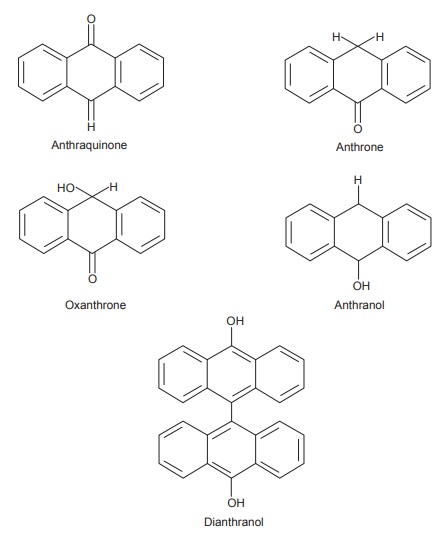Anthracene Glycosides
| Home | | Pharmacognosy |Chapter: Pharmacognosy and Phytochemistry : Drugs Containing Glycosides
Anthracene glycosides are chiefly found in dicot plants but to some extent it is also found in monocot and lower plants. It consists of glycosides formed from aglycone moieties like anthraquinones, anthranols, anthrones or dimers of anthrones or their derivatives.
ANTHRACENE GLYCOSIDES
Anthracene glycosides are chiefly found in dicot plants but
to some extent it is also found in monocot and lower plants. It consists of
glycosides formed from aglycone moi-eties like anthraquinones, anthranols,
anthrones or dimers of anthrones or their derivatives. Anthrones are insoluble
in alkali and do not show strong fluorescence with them, while anthronols which
are soluble in alkali show strong fluorescence. The reduced anthraquinones are
biologically more active. Anthroquinones that are present in fresh drugs are in
reduced form, which on long storage get oxidized and hydrolysed, Glycosides of
reduced derivatives are more active than oxidized aglycones. This is due to the
fact that sugars take the glycosides to the site of action and thus are more
active.
Anthraquinone is an aromatic organic compound and a
derivative of anthracene. It has the appearance of yellow or light grey to
grey-green solid crystalline powder. Its chemical formula is C14H 8O2.
It melts at 286°C, boils at 379.8°C. It is insoluble in water or alcohol, but
dissolves in nitrobenzene and aniline. It is chemically fairly stable under
normal conditions.
Anthraquinone naturally occurs in some plants (e.g. aloe,
senna, rhubarb and cascara), fungi, lichens and insects, where it serves as a
basic skeleton for their pigments. Natural anthraquinone derivates tend to have
laxative effects.
These glycosides are characterized by a chemical test, known
as Borntrager test and show the property of micro-sublimation. Most of the
glycosides are O-glycosides and

S-glycosides, by their hydrolysis derivatives of
1,8-dihydroxy anthraquinone, anthranol, anthrone, or dianthrone are obtained.
The common aglycones are aloe-emodin, emodin, rhein,
chrysophanol and physcion which may exist as anthraquinones, anthranols or
anthrones. The sugars presents are usually arabinose, rhamnose and glucose.
In the drug originally glycosides of reduced derivatives or
their dimers are present. During drying and storage by hydrolysis and
oxidation free anthraquinones are produced.
